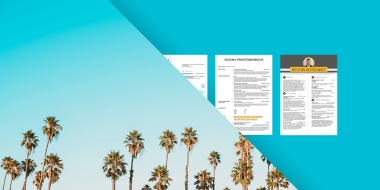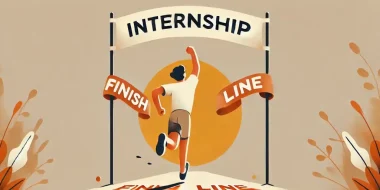Are you a college student looking for your first internship? Or perhaps a fresh graduate who’s about to apply for her first real job?
If so, then you’ve probably already tried to write your first resume — and became painfully aware of your lack of work experience.
Yet, even if you had a few moments when you felt useless (even the best soon-to-be graduates feel that way), you should remember that every person has skills and knowledge to show off.
The main challenge is discover and transcribe these skills and experiences into words in the right way.
In case of a college student resume, you can look to relevant courses or volunteering experiences. Or perhaps you were wise enough to do an internship during your studies.
In any case, we’ll show you how you can write a fantastic college student resume even if you’ve never worked a day in your life.
CHAPTER 1: Before You Start Writing
Like all things, a good resume starts with having the right mindset. The mindset you adopt during writing will reflect in the impression your resume will give off once it's finished.
Yet, the most important thing about writing powerful resumes might sound a bit counter-intuitive at first: Your resume shouldn’t be about you, it should be about the employer.
Instead, it needs to present you as a capable candidate who'll be an asset to the company you're approaching. Do you still have no idea how can you be an asset to a great company with your current skill level?
Why would anyone want to hire a fresh graduate?
There’s no reason to feel intimidated. Even if you have no experience under your belt, there are people out there who’ll be glad to employ you.
Still, you might be asking, why exactly would an employer want to hire someone who has next to no experience?
There are several reasons. Keep these things in mind and make sure at least some of them reflect in your resume.
- Quick learning and adaptability. You’re a blank canvas. Since it’s probably going to be your first work experience, your employer will be able to shape you role however they see fit within the business.
- Saving on employee salaries. As an entry level employee, you’re probably willing to work for significantly lower salary than seasoned professionals.
- Comfortable with new technology. Recent graduates have grown up around technology and have developed the ability to pick up new tools rapidly.
- Investing into someone who shows potential. Talented people are scarce and far in between. If you invest into someone who shows potential early, your investment will return later.
- Enthusiasm. Everyone is excited about their first job and will work their hardest in order to make a good impression. Graduates bring bounds of creative energy and are more competitive than employers later in their career.

6 Tips to Remember Before You Start Writing Your Resume
Managers are expected to solve hundreds of tiny problems every day. Making the decision as for whether to hire you or not is going to be one of those problems.
You want to help them solve it as painlessly as possible.
- Be relevant. A hiring manager wants to know whether you’re going to bring value to the company and be a good fit for their company culture. Your resume should give them a clear answer to that question. Asking the ‘so what’ question witch each bullet point will help you achieve that.
- Follow the 6 seconds rule. Most recruiters only spend about 6 seconds reading each resume. Make sure your strongest points immediately discernible to make a recruiter give your resume a second look.
- Pack your resume with keywords. Take a closer look at the job advertisement and scan it for a number of words that best describe the position. Include them in your resume. Incorporating keywords will help you get through these applicant tracking systems so your resume gets to a hiring manager.
- Avoid using buzzwords. Some phrases have been used so much in resumes they became meaningless. Avoid words such as “thinking outside the box”, “creative” or “problem solver.” For a more complete list, check this article.
- Use action verbs. While buzzwords are highly discouraged, there are some power words you might want to use. These include expressions such as “achieved”, “advised”, “delegated” and others. Check out this list for more.
- Fit your resume on a single page. As a college student, you certainly don’t have enough experience to fill 2 pages.

CHAPTER 2: How to Write a Great College Student Resume in 6 Easy Steps
The format of your resume will heavily depend on the information you have to work with. If you have a lot of of internship experience, you’ll want to highlight it just bellow your summary and education sections.
On the other hand, if you didn’t have any jobs related to your desired career, you can play up your education.
If the job requires technical skills like C# or Ruby, consider putting it just below the education section and right above your work experience.
In any case, always make your resume revolve around your greatest strengths and adjust its structure accordingly.
1. Personal details
You don’t have to fret too much about this section. It only becomes relevant once your resume catches an employer’s attention. For this reason, you also don’t want to give it too much space on the page.
Insert it into the header of your resume and follow these simple guidelines:
- Contact details. Put your name at the beginning of your resume. Don’t forget to include your email address and telephone number. Make sure your email address sounds professional. It’s nigh impossible to be taken seriously with an email address like sexyboy1990@hotmail.com.
- Address. If your address is close to the workplace you’re applying to, include it in your resume as it could be seen as a positive. This can be an address of your student accommodation, college, or home address. Just put the one that’s closest to the job. Usually, it’s enough to provide your city and state, e.g. Kent, Washington.
- Links to your online profiles. This includes your LinkedIn profile, personal website and/or your web portfolio. Don’t forget to customise your public LinkedIn URL so it looks something like this: “www.linkedin.com/in/yourname” (default version is pretty difficult to read or transcribe as it contains special characters and numbers). Just click the “Edit your public profile” button in the top-right corner of the page.
- Don’t include your photo. Be careful with this one! In some countries, including your photo is a common practice, in most others just an awkward faux pas. A great majority of experts agree that it’s better not to include a photo on your resume (and a college student resume is no different) unless you’re explicitly asked otherwise.
Example: Personal Details
2. Professional Summary / Objective Statement
Your resume should never focus on what YOU want. On the contrary, it should tell a potential employer why THEY want to hire you. What’s the best way to do it?
Write a professional summary that clearly summarises the key qualifications you have to offer a potential employer. Also, don’t forget to include any relevant experiences or skill that can set you apart from other candidates.
Let’s say you worked your way through college financing your own education. This demonstrates your dedication and work ethic. Receiving a scholarship proves your academic excellence. Or perhaps you had a great internship experience. Take your time to pick those accomplishments that are closely related to the job you’re applying for. Most importantly, keep it short and relevant. Avoid anything vague.
Example: Professional Summary
3. Education Summary
As a fresh graduate or college student, you should put the education section above your work experiences. After all, your degree is probably still one of the strongest cards you can play at this point.
Therefore, every college student resume should list their academic distinctions such as summa cum laude, scholarships, honours such as dean’s list, and other awards.
Only list your GPA if it’s higher than 3.0 on a 4.0 scale. If your overall GPA is lower than that, mention your major GPA. Highlight your accomplishments and consider adding those of your courses that are related to the job you’re applying for. If you’re yet to graduate, include your graduation date.
Example: Education Summary
4. Skills Summary
Depending on the information you have to work with, it will be either the work experience or the skills section that will take up most space. If you’ve done several internships and have acquired some experience to speak of, you can simply follow regular resume guidelines.
Yet, the approach that most experts recommend in case of a college student resume is to focus on your skills. This is what they call a “functional resume.”
Read through the job description again and select skills that are crucial for the position. See how they overlap with your own skills and group your experience under each of the respective skills headings.
Notice that no company names or job titles are mentioned here. These will be listed in the work history section. However, don't hesitate to mention any class projects, volunteer work or extracurricular activities that demonstrate your ability and are related to your target job.
Example: Skills
5. Work History
In the end, employers want to see those dates and positions. Now that you’ve done most of the work in the previous section, all there’s left to do is to list your work experiences chronologically. Include dates, company names, and job positions.
Don’t forget to list your volunteering positions too. It might not be a paid work experience but it’s an experience nevertheless.
At the same time, volunteering looks insanely good on any college student resume. It speaks volumes about your character, work ethic, and social engagement.
Example: Work History
6. Testimonials
Don’t be afraid to insert testimonials at the end of your college student resume. They say more about you than you could ever explain yourself. First, when you describe yourself, it can easily sound like bragging. Second, as a student, you have no authority yet. Let your mentors, supervisors, and professors do the bragging for you.
Witch each testimonial, include the person's name, title and position. If they only gave you a full-blown recommendation letter, extract 1-3 sentences and make sure you don’t take them out of context.
Example: Testimonials
Final tips to consider before you press "Send"
- Use off-peak hours for maximum attention, especially if you’re reaching out to an employer directly. Hiring managers are busy people and you want them to receive your resume when they have enough time to read through it.
- Always follow-up. If you receive no answer within several days after submitting your resume, don’t hesitate to send a follow-up email to remind the company of your application.
- Break some rules. Don’t be afraid to adjust the resume structure we’ve outlined above. Always think about how can your college student resume best communicate your strengths.
- Tailor your college student resume for every role. A generic resume will always miss the mark. It’s impossible to keep your resume relevant if you don’t consider particular demands of every job. Review the job description and modify your resume accordingly.
- Your formatting needs to be consistent. All typefaces should be the same and sizing should be consistent throughout a resume. The same applies to spacing and capitalising.
- Check your resume for typos. Having typos in your resume means an instant death for your application. It portrays you as careless and even incompetent for not using the spellcheck feature in your text editor.
- Attach a cover letter. Your resume should never go unaccompanied. Write a short cover letter and insert it into the body of your email. If you don't know how to write one, check out our Complete Guide to Writing Powerful Cover Letters.
Give your learning a boost, explore our wide array of resume samples. Get inspired to create a resume that paves your way to a promising career.



